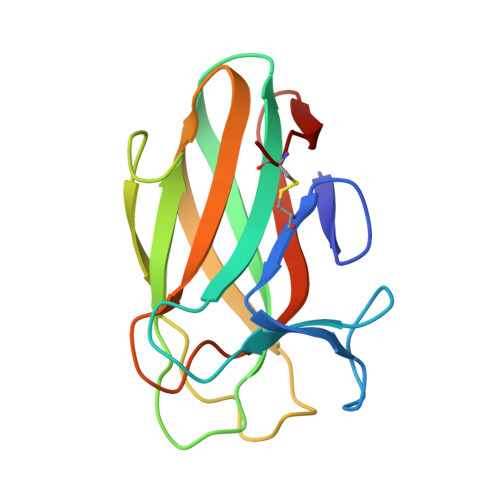Evidence that Family 35 Carbohydrate Binding Modules Display Conserved Specificity But Divergent Function.
Montanier, C., Van Bueren, A.L., Dumon, C., Flint, J.E., Correia, M.A., Prates, J.A., Firbank, S.J., Lewis, R.J., Grondin, G.G., Ghinet, M.G., Gloster, T.M., Herve, C., Knox, J.P., Talbot, B.G., Turkenburg, J.P., Kerovuo, J., Brzezinski, R., Fontes, C.M.G.A., Davies, G.J., Boraston, A.B., Gilbert, H.J.(2009) Proc Natl Acad Sci U S A 106: 3065
- PubMed: 19218457
- DOI: https://doi.org/10.1073/pnas.0808972106
- Primary Citation of Related Structures:
2VZP, 2VZQ, 2VZR, 2W1W, 2W3J, 2W46, 2W47, 2W87 - PubMed Abstract:
Enzymes that hydrolyze complex carbohydrates play important roles in numerous biological processes that result in the maintenance of marine and terrestrial life. These enzymes often contain noncatalytic carbohydrate binding modules (CBMs) that have important substrate-targeting functions. In general, there is a tight correlation between the ligands recognized by bacterial CBMs and the substrate specificity of the appended catalytic modules. Through high-resolution structural studies, we demonstrate that the architecture of the ligand binding sites of 4 distinct family 35 CBMs (CBM35s), appended to 3 plant cell wall hydrolases and the exo-beta-D-glucosaminidase CsxA, which contributes to the detoxification and metabolism of an antibacterial fungal polysaccharide, is highly conserved and imparts specificity for glucuronic acid and/or Delta4,5-anhydrogalaturonic acid (Delta4,5-GalA). Delta4,5-GalA is released from pectin by the action of pectate lyases and as such acts as a signature molecule for plant cell wall degradation. Thus, the CBM35s appended to the 3 plant cell wall hydrolases, rather than targeting the substrates of the cognate catalytic modules, direct their appended enzymes to regions of the plant that are being actively degraded. Significantly, the CBM35 component of CsxA anchors the enzyme to the bacterial cell wall via its capacity to bind uronic acid sugars. This latter observation reveals an unusual mechanism for bacterial cell wall enzyme attachment. This report shows that the biological role of CBM35s is not dictated solely by their carbohydrate specificities but also by the context of their target ligands.
- Institute for Cell and Molecular Biosciences, The Medical School, Newcastle University, Newcastle upon Tyne NE2 4HH, United Kingdom.
Organizational Affiliation:


















